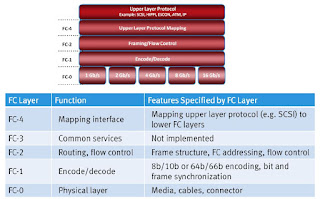Fibre Channel Layers
It is easier to understand a communication protocol by viewing it as a structure of independent layers. Fibre Channel Protocol defines the communication protocol in five layers: FC-0 through FC-4 (except FC-3 layer, which is not implemented).
FC-0 Layer is the lowest layer in the Fibre Channel Protocol stack. This layer defines the physical interface, media, and transmission of bits. The FC-0 specification includes cables, connectors, and optical and electrical parameters for a variety of data rates. The Fibre Channel transmission can use both electrical and optical media.
FC-1 Layer defines how data is encoded prior to transmission and decoded upon receipt. At the transmitter node, an 8-bit character is encoded into a 10-bit transmission character. This character is then transmitted to the receiver node. At the receiver node, the 10-bit character is passed to the FC-1 layer, which decodes the 10-bit character into the original 8-bit character. Fibre Channel links with speed 10 Gbps and above use 64-bit to 66-bit encoding algorithm. This layer also defines the transmission words such as Fibre Channel frame delimiters, which identify the start and end of a frame and primitive signals that indicate events at a transmitting port. In addition to these, the FC-1 layer performs link initialization and error recovery.
FC-2 Layer provides Fibre Channel addressing, structure, and organization of data (frames, sequences, and exchanges). It also defines fabric services, classes of service, flow control, and routing.
FC-4 Layer is the uppermost layer in the Fibre Channel Protocol stack. This layer defines the application interfaces and the way Upper Layer Protocols (ULPs) are mapped to the lower Fibre Channel layers. The Fibre Channel standard defines several protocols that can operate on the FC-4 layer. Some of the protocols include SCSI, High-Performance Parallel Interface (HIPPI) Framing Protocol, Enterprise Storage Connectivity (ESCON), Asynchronous Transfer Mode (ATM), and IP.
FC-0 Layer is the lowest layer in the Fibre Channel Protocol stack. This layer defines the physical interface, media, and transmission of bits. The FC-0 specification includes cables, connectors, and optical and electrical parameters for a variety of data rates. The Fibre Channel transmission can use both electrical and optical media.
FC-1 Layer defines how data is encoded prior to transmission and decoded upon receipt. At the transmitter node, an 8-bit character is encoded into a 10-bit transmission character. This character is then transmitted to the receiver node. At the receiver node, the 10-bit character is passed to the FC-1 layer, which decodes the 10-bit character into the original 8-bit character. Fibre Channel links with speed 10 Gbps and above use 64-bit to 66-bit encoding algorithm. This layer also defines the transmission words such as Fibre Channel frame delimiters, which identify the start and end of a frame and primitive signals that indicate events at a transmitting port. In addition to these, the FC-1 layer performs link initialization and error recovery.
FC-2 Layer provides Fibre Channel addressing, structure, and organization of data (frames, sequences, and exchanges). It also defines fabric services, classes of service, flow control, and routing.
FC-4 Layer is the uppermost layer in the Fibre Channel Protocol stack. This layer defines the application interfaces and the way Upper Layer Protocols (ULPs) are mapped to the lower Fibre Channel layers. The Fibre Channel standard defines several protocols that can operate on the FC-4 layer. Some of the protocols include SCSI, High-Performance Parallel Interface (HIPPI) Framing Protocol, Enterprise Storage Connectivity (ESCON), Asynchronous Transfer Mode (ATM), and IP.


Comments
Post a Comment